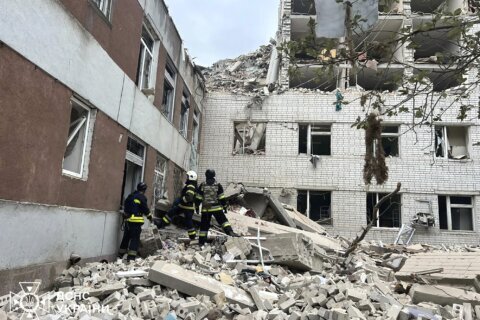WASHINGTON — The State Department on Monday issued a travel warning to U.S. citizens about what it called the “continued threat of terrorist attacks throughout Europe.”
The broad alert for all of Europe, which expires on Sept. 1, is based on “recent, widely reported incidents” in France, Russia, Sweden and the United Kingdom that demonstrate that the Islamic State of Iraq and the Levant (ISIS), al-Qaida and their affiliates “have the ability to plan and execute terrorist attacks in Europe.”
Not only are authorities worried about the likelihood of more frequent attacks, but the type of attacks is even more troubling.
Intent on maximizing the impact of low-budget attacks, terrorists have altered how they select targets, several current and former U.S. and European Union, officials said.
“The character of terrorist attacks has changed in the past couple of years. Today, ordinary citizens and crowds of people are the target, and you can never predict where the attack might happen,” said Johannes Hahn, European Union commissioner for European neighborhood policy and enlargement negotiations, during an April 21 visit to D.C.
During six attacks in Europe since July 2016, simple tactics were used to attack civilians and security officers. More than 120 people have been killed in attacks in London, Stockholm, Berlin, St. Petersburg, Nice and Paris. Those varied attacks involved vehicles (to run over victims), rifles, knives and explosive devices.
Simpler tactics
“What we have seen over time is that homegrown violent extremists (HVEs) — either lone actors or small insular groups — tend to gravitate toward simple tactics that do not require advanced skills or outside training,” said National Counterterrorism Center Director Nicholas Rasmussen during testimony before the Senate Homeland Security and Governmental Affairs Committee in September 2016.
“We expect that most HVEs will likely continue to select traditional targets, such as military personnel, law enforcement and other symbols of the U.S. government,” Rasmussen said at the time.
“Although during the past year, we have seen HVEs plotting against softer civilian targets, as was the case in St. Cloud, Minnesota; in the Chelsea neighborhood in Manhattan; and in Seaside Park, New Jersey, most recently.”
After the U.S.-led military coalition started destroying ISIS bases in Iraq and Syria in 2015, the group began changing its tactics.
On the heels of high-profile directed attacks in Paris and Brussels, during which more than 160 people were killed, authorities began dismantling the group’s operational base in Europe. At that point, ISIS simplified its target-selection process.
In fact, Abu Mohammad al-Adnani — who had been the spokesman for ISIS before he was killed Aug. 30 — told followers to attack Westerners using any weapon they could find.
“Smash his head with a rock, or slaughter him with a knife, or run him over with your car, or throw him down from a high place, or choke him, or poison him,” said Adnani.
An outdated handbook
“Terror attack tactics have certainly changed over the past several years. Security services that are still reading the al-Qaida handbook on target selection are behind the curve,” said Mike Maness, the director of TrapWire Inc., who served 20 years as a CIA counterterrorism operations officer.
High-value, iconic targets with mass causalities, as described in the handbook, are no longer the norm, Maness said.
“While every terror organization would certainly like to replicate 9/11, they see that the world has changed, and planning these types of complicated, grand-scale operations is much more difficult,” he said.
As a result, terror groups have adapted.
“As we harden iconic and high-value targets, they shifted to soft targets and crowded spaces. As we improved our signals intelligence (SIGINT) collection techniques, they shifted to TOR and encrypted apps. And as we started going after known terrorists and their accomplices, they started using social media to radicalize lone wolves with little or no previous connections to their organizations,” Maness said.
ISIS responded to the loss of territory and the withering attacks by U.S.-led forces on its sanctuaries by encouraging sympathizers to stay at home and attack targets of their own choosing.
“Some HVEs — such as the Orlando shooter and the San Bernardino shooters in December 2015 — may have conducted attacks against personally significant targets,” Rasmussen said. “The convergence of violent extremist ideology and personal grievances or perceived affronts likely played a role in motivating these HVEs to attack.”
Hahn said a growing number of people have been drawn into the evolving terrorist philosophy because of their own difficult circumstances. “In particular, young people that have no economic perspective are targets of radicalization,” he said.
A focus on “tourist locations”
Extremists, according to the State Department alert, “continue to focus on tourist locations, transportation hubs, markets/shopping malls and local government facilities as viable targets.
“In addition, hotels, clubs, restaurants, places of worship, parks, high-profile events, educational institutions, airports and other soft targets remain priority locations for possible attacks,” the alert said.
Authorities warn that terrorists now use firearms, explosives, vehicles (as ramming devices) and sharp-edged weapons that are difficult to detect prior to an attack.
As the pool of potential terrorists grows, the methods they use to attack, partly due to online tutorials and provocations, have become more diverse. That, according to a U.S. intelligence official, “makes it harder to cover all the possible scenarios.”
In addition to contacting the State Department once arriving abroad, the alert warns, “While local governments continue counterterrorism operations, the Department nevertheless remains concerned about the potential for future terrorist attacks. U.S. citizens should always be alert to the possibility that terrorist sympathizers or self-radicalized extremists may conduct attacks with little or no warning.”








